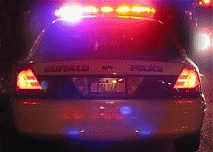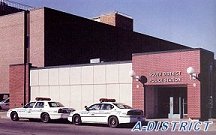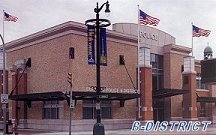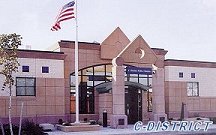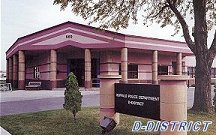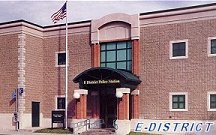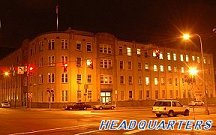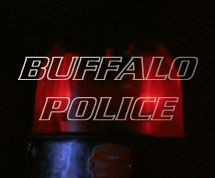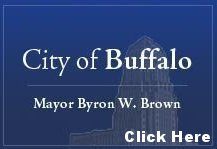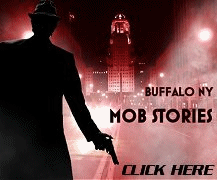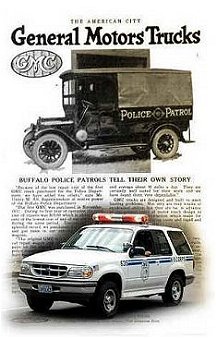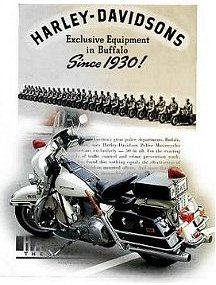|
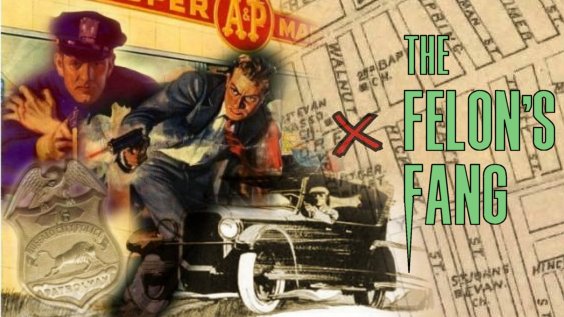
|
|
|
|
The Felon's Fang
The Hunt Is On For A Buffalo Cop
Killer.
Following the Lightning Path of
Buffalo’s Green-Tooth Slayer By Captain GEORGE F. TOURJIE,
Buffalo New York Police Department
True Detective Magazine, November 1940, |
| By J.
HOWARD GARNISH |
Deborah Kufel - Typist |
|
The Winter of
1929-1930 was a tough one for Buffalo Police. Fighting gangs
of bootleggers, hijackers and rum-runners were making the
snowy
Niagara
frontier a crimson
battleground.
Narcotics
peddlers were stealthily pursuing their nefarious calling.
Lightning thrusts or armed robbers kept merchants cowed.
Federal agents
co-operated with the police in the war on liquor runners, dope
and vice. But the robberies were the police department’s own
problem-a headache shared by all of us from Commissioner
Austin J. Roche down to the patrolman pounding their beats,
and including me and my fellow-members of the auto squad |
|
|
|
|
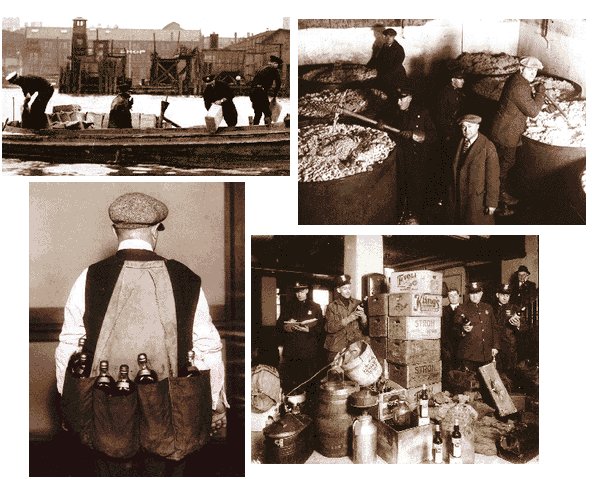
|
| From
late in September until the first of February , forty-one
holdups had been reported in the city and only eight arrests
had been made.
The newspapers
clamored for action. We were even more anxious than they to
wipe the unsolved cases off our records. Every apparently
successful stickup, we knew, lent encouragement to scores of
young fellows who thought armed robbery an easy to make a
living. But as hard as we tried, the list of unsolved cases
grew longer.
Some of the robbers
worked in bands, others in pairs, but several operated alone.
The elusive
A&P bandit was one of these. Since the previous November
he had robbed managers of
East Side
grocery stores of
money mounting into the thousands of dollars.
Holdups in a few
stores belonging to other chains were attributed to him, but
branches of the Great Atlantic & Pacific Tea Company
appeared to be his favorites. Our records accused him of ten
of these jobs in about the same number of weeks. |
|
|
|
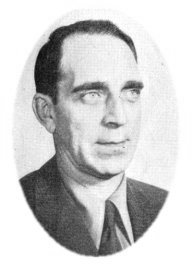 |
His
procedure was well patterned. Early Monday morning, before the
Saturday receipts had been banked, he would enter a store when
no customers were present, whip out a revolver, force the
manager, and clerk if one were present, to reveal where the
store’s cash was hidden, and truss his victims up in the
rear room with clothesline from the store’s stocks.
Hastily stuffing his haul into his pockets, he would dash
to a car parked near by and speed away. His visits were brief
but effective. By the time the police arrived he had vanished
like a phantom.
Store managers told
our detectives that the gunman was a slim, blond young man,
about five feet ten, with a scar on his lip and wearing
sideburns, a fashion that became popular among the
“sheiks” of that day in imitation of Rudolph Valentino.
And several
managers added-as the bandit curled his lip back to snarl his
commands, he bared a discolored front tooth of a greenish hue. |
|
Captain George F. Tourjie Buffalo Police
Department |
| The
detectives poured over record cards of known robbers in an
endeavor to find the one with a greenish tooth and a scarred
lip. They found nobody answering that description. They
summoned store managers to Headquarters to examine pictures of
likely suspects. Looking at the rogues gallery of photographs,
the managers shook their heads.
Studying the
detectives reports of the chain store stickups, Commissioner
Roche and Night Chief William R. Connolly looked for
information on the man’s operations. Finally the
Commissioner smashed a fist on his desk. |
|
|
|
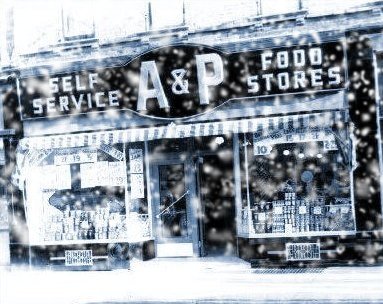 |
“it’s
useless to chase this fellow!” he exclaimed. “we’ve got
to trap him! Most of his jobs have been pulled on Monday
mornings, so from now on our men are going to be waiting for
him.
A patrolman will
be stationed every Monday morning in each A&P store in the
vicinity in which he has been operating. The patrolmen will
have to work overtime, but these robberies must me stopped”
The baited traps
were set, but after a month the bandit still had eluded
capture. Perhaps he got |
| wind of the preparations for his
reception, for he suddenly changed his operating methods.
He
robbed a couple of stores outside the guarded district, then
shifted his forays from Monday mornings to Saturday nights,
just before closing time. He was still making big hauls and a
good portion of the force continued to lose sleep waiting for
him.
When Commissioner
Roche heard that he had been outmaneuvered, he became
thoughtful. “It’s tough to put extra loads on the
patrolmen” he told Chief Connolly, “but we’ve got to get
this man.
Have a policeman
assigned to each store for an hour before closing time every
Saturday and continue the morning details. If he keeps, he’s
got to walk into the trap sooner or later.” |
|
|
|
|
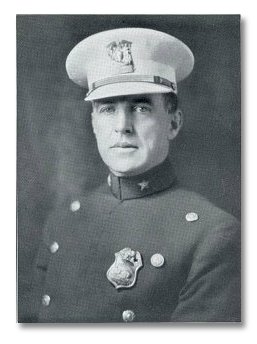
Commissioner
Austin J. Roche
|
Patrolman
Carl L. Wunderlich was one of the men called upon for extra
duty as part of the elaborate snare. Thus it was that , after
pounding his beat through the snowy night
and the gray dawn
of
February 3rd,
1930
he rapped sharply on
the door of the A&P store at
646 Sycamore Street
, near
Sherman
.
Joseph S. Braun,
twenty-two, of
118 Lemon Street
, acting manager of
the branch during the illness of his father, emerged from the
back room carrying a basket of vegetables to place on the
display. Heeding the knock, he deposited his load on the floor
and stepped to the door.
Patrolman
Wunderlich entered, stamping snow from his feet.
“Hope you’ve
got a good fire, Joe,” the policeman remarked. “This is
blue Monday and I’m just about blue from the cold. The
temperature’s been dropping since
midnight
.”
“I got the stove roaring as soon as I came to open up,”
Braun responded. “It’s fairly warm in the back room
now.” |
| “Doggone
you’re A&P bandit,” groused Wunderlich. “If it
weren’t for him I could be on my way home by now.”
“Well, if he shows up you better be ready for him,” Braun
countered. “We had a lively Saturday night trade and I’ve
got quite a stack of money hidden in back waiting for the bank
to open.”
Patrolman Wundelich stood for a moment longer inside the
door, watching Braun and his assistant, Harold R. Chapin,
twenty-three, arranging displays.
To
the right of the entrance a growing accumulation of trays and
baskets contained fruits and vegetables. To the left stood the
long grocery counter, the cash register at the wall behind it.
At the rear of the store, forming an L with the grocery
counter, was the shorter butter and cheese counter.
The
patrolman’s gaze turned to the partition that separated the
store from the rear room.
“Say,
when are you going to move those bags of potatoes from that
wall and bore a peephole there for me? He asked.
Young
Braun was apologetic.
“I
don’t like to take that responsibility, Carl,” he
responded. “Maybe, when Dad gets back…”
“I
might as well be home in bed as guarding this place,” the
policeman remarked ruefully. “I’d have to stand in the
doorway back there to know what’s going
on out here. Well, I’m going back by the stove.”
He
stalked to the entrance to the rear room, which was placed
midway of the partition, just beyond the end of the butter
counter and about on a line with the front door.
Turning
as he passed through the doorway, he skirted a masking
partition which hid the rear room from the curious eyes of
customers.
In
a little while Chapin came back an sat down a short distance
from the patrolman to work on the store’s books. |
|
|
|
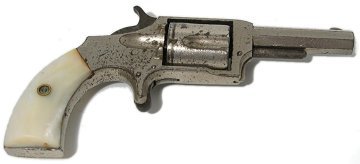 |
Shortly
after
eight o’clock
, Braun was crouched
in the front window, taking an inventory of special sale
merchandise. A blond young man entered, his hands in his
pockets and his coat collar turned high against the cold and
snow.
Descending
from the window, Braun stepped behind the counter and asked
politely: “what will you have?”
|
|
For answer, the man
snatched his right hand from his overcoat pocket and leveled a
nickel-plated revolver at the white-aproned figure of the
manager.
“Get
to the back!” he ordered softly.
Braun
stared apprehensively at the man’s ruthless face, which
showed a scar slitting the thin lips. He regarded the weapon
in the bandit’s hand and wondered if Wunderlich and Chapin
had heard.
“What
do you want?” he asked as loudly as he dared, but his voice
shook uncertainly.
The
gunman leaned forward menacingly and merely gestured again
toward the rear room.
Braun
dared not shout, for fear of being shot. He could only hope
that Wunderlich had been warned and standing behind the
masking partition, his revolver cocked and ready.
The robber’s gun followed the manager as he
edged along the grocery counter, turned behind the butter
counter and reached the doorway.
It was shoved into his ribs as he backed through and
followed the masking partition.
As the pair approached the end of the shorter
partition, the gunman’s face twisted into a snarl.
Braun, facing him, caught a glimpse of a greenish
tooth. “Get the
stuff!” the bandit ordered. Hearing
the command, Chapin slipped into an alcove, out of sight. |
|
|
|
|

|
| In the same instant,
Braun saw the bandit’s alert eyes sweep the room and catch
sight of the policeman.
The manager was shoved aside.
A shot split the air. The
gunman turned and fled.
Regaining his balance, Braun dashed through the opening in
the partition, dove behind the counter and listened for
Wunderlich’s revolver to reply.
After a second’s wait, he called to the patrolman:
“Don’t shoot! The
holdup man’s gone.
”Just then Wunderlich staggered through the doorway into
the front of the store, his gun in his hand.
Blood streamed down his face.
As he came abreast of the butter counter, he collapsed
to the floor and began to moan.
Chapin dashed to his side. |
|
|
|
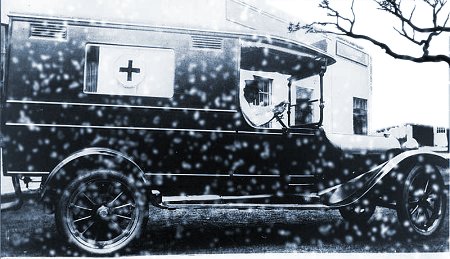 |
Braun ran outside and confronted a neighbor.
“Call Police Headquarters and get an ambulance” he
shouted. “A policeman
has been shot!”
The shrill screech of an ambulance siren mingled with the
scream |
|
of police cars as the vehicles drew up to the store.
Detective Sergeant John J. Whalen and his homicide squad
cleared a path through curious onlookers for the ambulance
crew. Kneeling beside
the prostrate blue-coated figure, the ambulance surgeon made a
quick examination.
“Shot through the right side of the face,” he murmured
to Detectives Walter A. Holz and John J. Fitzgerald.
“It looks as though it had pierced his jaw and
neck.” The surgeon
shook his head doubtfully.
He helped to lift the wounded patrolman on a
stretcher and the ambulance sped him to
Memorial
Hospital
.
While Carl Wunderlich fought for his life, the
entire might of the police force was whirled into action to
hunt down the criminal who had to shoot him before he’d had
a chance to draw.
Commissioner Roche ordered all policemen,
including day and night shifts, to work a seven-day week and
recalled immediately all men on leaves of absence.
He issued a call for volunteers for raiding
parties that night. More
than 100 patrolmen and detectives, who had already done their
normal tour of duty that day responded. |
|
|
|
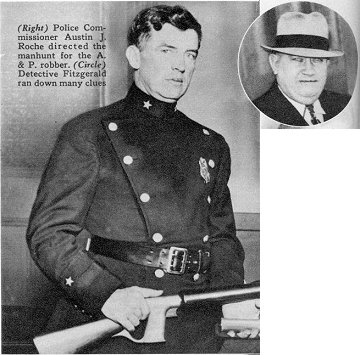 |
A detective with the auto squad, I was
assigned to a day trick that week, but I joined the raiders.
The Commissioner was very earnest when we
assembled at Headquarters for instructions.
“Men”, he said solemnly, “you know
that last Saturday night two young bandits killed Adam Lampke
in his butcher shop in
East North Street
when he resisted them. Today
the A&P bandit has shot a patrolman-the very symbol of law
and order-and this officer will probably die.
These shootings must stop.
|
| “The homicide squad has a line on some
suspects, but we can’t rest with that.
I want you to go out and bring in for investigation
every suspicious character you can find.
Grab any one with a police record.
Be on your guard for any of these men may be a killer.
Don’t shoot unless you have to, but if you shoot,
don’t miss. All
right, get going!
The
dragnet that night swept in 400 men.
Some of them had been on our “wanted” list for
months.
For three days the cells at Headquarters and in the
precinct stations bulged with prisoners.
Several were booked on serious charges and eventually
convicted. But most of
them, after questioning and a checkup of their activities,
were released or received suspended sentences as leased or
received suspended sentences as vagrants.
A few meager clues about the A&P bandit proved
worthless.
Patrolman Wunderlich died the next afternoon, leaving a young
widow and a baby daughter, Audrey.
He had been married only two years.
We were all grimly determined that if the chance came the
bandit would pay dearly for his wanton killing.
Grimmest of all was Carl’s brother, Detective Henry
F. Wunderlich, one of my fellow-members of the auto squad.
Taking his dead brother’s service revolver, he swore
he would hunt down the killer.
All of us pledged our help.
Detective Sergeant Whalen and his homicide squad had been
busy piecing together fragments of information.
The store manager and his assistant gave descriptions
of the killer. Braun
mentioned the gunman’s sideburns and greenish tooth.
Charles Kelley, of 479 Sherman Street, had been walking
near his home the morning of the shooting, he told Detectives
Holz and Fitzgerald, when he saw a man dash around the corner
from Sycamore Street, leap into a black coupe parked in
Sherman Street about 100 feet from the corner and sped north.
The man wore a light-colored cap and a light overcoat
that came down below his knees.
The manager of the A&P branch at
440 Genesee Street
came forward with another morsel of information.
On the morning that Carl Wunderlich was wounded, he
reported, a young man, heavily built, about five feet ten
inches tall, wearing a light overcoat and light cap and a
white shirt without a collar, tried the door before the store
was opened.
The manager stepped to the front window and saw the man
walk to a car parked nearby, get in, and drive away.
He gave police the license number.
They learned the automobile had been stolen the
previous night from the janitor of a factory in the
neighborhood. It was
located soon afterward, abandoned.
Detectives theorized that the bandit, failing to gain
entrance to the
Genesee Street
store, had driven a few blocks to the
Sycamore Street
grocery where he had encountered and slain Wunderlich.
Detective Chief Emanuel Schuh showed the investigators’
reports to the Commissioner Roche, who studied them closely.
“I’ll have to turn the auto squad loose on this
fellow!” he exclaimed. He
summoned Lieutenant Arthur D. Britt, our squad leader.
“This killing,” the Commissioner told him, “will
probably compel the gunman to lie low for a while.
We know definitely now that he uses stolen cars for his
jobs. Sooner or later
he’ll steal another one. It
looks like a task for your man to nail him.
Get a line on his identity and track him down.”
In those days, before the advent of two-way police radios,
members of our squad saw plenty of action.
Our stolen car list regularly contained thirty to
thirty-five and even forty entries.
Today it will rarely exceed five.
While some of the car thieves were merely joy riders who
used the machines until the gas supply dwindled, more of them,
we knew, were hard-boiled gunmen with nervous trigger fingers.
The auto squad had been chosen to match the daring and
shooting prowess of the desperadoes it was likely to
encounter. Nearly every
member was a veteran of at least one gun battle with
criminals.
We knew the gunmen’s technique well.
They would steal a car, pull a robbery, and then
quickly abandon the machine. Another
favorite device was for thugs to step up to an amorous couple
in a parked auto, force them at gunpoint to surrender the
wheel, dump them out in a lonesome spot in the country, far
from a telephone, then use the car in a robbery before police
had learned it was stolen.
When Britt relayed the Commissioner’s orders, we nodded
grimly. “Be careful
with your guns,” our leader added.
“Don’t shoot heedlessly, but be on your guard every
instant. Remember this
criminal has killed one of the best shots in the department.
He’d just as soon kill another.”
We sallied forth, armed, to the teeth, but soon found that
the Commissioner’s surmise was correct.
Weeks went by and no new A&P stickups were
reported. We concluded
that the gunman was lying low, waiting until the “heat”
was off.
Meanwhile, the homicide squad and other officers in the
department ran down some hot leads.
What appeared to be the hottest came from Charles A.
Braden, a dispatcher for the Greyhound Bus Company at its
terminal at Court and Pearl Streets.
“About ten-thirty p.m. on the day Wunderlich was shot,”
Braden told Desk Lieutenant Walter E. Jackson, “a man about
thirty years-old, wearing a red and black lumber jacket, came
into the terminal and asked for a taxi.
None was there, so he called the Van Dyke Taxi Company
and asked to have one sent over.
The taxi dispatcher evidently asked him his name, for
he answered, “What difference does it make?”
Then he gave a name I didn’t understand.
I was reading an early edition of the morning paper as he
waited. He came up to
me and asked whether the policeman died who was shot at the
A&P grocery. He
became very nervous and pulled quite a sum of money out of his
pocket and counted it several times.
He hid in the corner as I walked to the top of the stairs.
He asked me if the taxi was in sight.
I told him I saw one coming.
He came as far as the door, then looked in both
directions before going out. As
the taxi drove away, “I took its license number.”
Police contacted the cab driver, Leavit Wilcox,
103 Maple Street
. He told where he had
taken his fare and added: When
I arrived there, he did not get out immediately.
He paid me while in the cab, and then I noticed a woman
come to a window and look out.
He then got out of the cab and ran to the side door of
the house. The woman
seemed nervous. “I
saw her go to the rear of the house, as if to let him in.” |
|
|
|
|
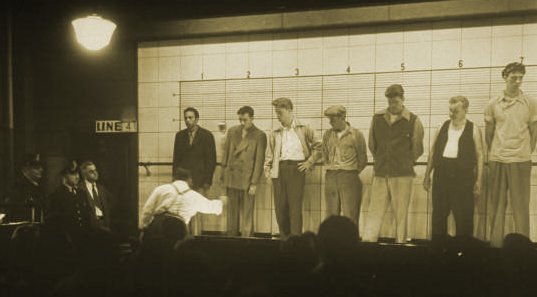
|
|
|
| A squad of detectives
sped to the address given by Wilcox.
The man was arrested, brought in and persons who had
seen the killer viewed him. But
they said he was not the man.
Inspections of the rogue’s gallery by murder witnesses
turned up another hopeful lead.
After they had selected a picture, which they said,
“looked like” that of the slayer, investigation disclosed
that the man had left
Buffalo
the day of the shooting. A
devious trail led police to
Toledo
,
Ohio
, where he was picked up, waived extradition and was returned
to
Buffalo
. But when store
employees viewed him in the “show-up,” they shook their
heads again.
It was one of the many false leads.
But Night Chief Connolly was confident he had a more
hopeful one when about two weeks after the Wunderlich slaying,
he trapped a youthful desperado named Dombkiewicz into
spilling a tip about an acquaintance.
Petey Dombkiewicz; his sweetheart, Sally Joyce Richards,
and a third member of the “Gold Band Gang” had just been
returned to
Buffalo
after their capture in
Montgomery
,
Alabama
. Sally later pleaded
with the judge, who sentenced them both to Auburn Prison for
robbery, that she be permitted to marry Petey.
Knowing that the diminutive Dombkiewicz had lived near the
scene of the A&P stickup slaying and was widely acquainted
in the underworld, Connolly had him brought to his office,
ostensibly for a casual conversation.
The Night Chief led the conversation around to the A&P
holdups. Petey seemed willing to talk.
“That guy’s using hot cars,” Petey asserted,
apparently enjoying his role of oracle for the police.
“Some of them he snatches from parking lots and some
from the streets.”
Connolly had dug out fifteen or twenty pictures of chaps
who answered the description of Wunderlich’s slayer.
Several of them wore sideburns and some had defective
teeth, but police didn’t have anything definite against
them.
The pictures lay on Connolly’s desk as the pair talked.
It was a shot in the dark, but he picked up the
pictures and started going over them with Petey to watch his
reaction.
The prisoner had looked at several of them and the Night
Chief had about given up hope.
The officer showed him another.
Petey gave Connolly a hasty glance, started to say
something, then stopped in confusion.
“Know him, Petey?” Connolly
asked, but the prisoner saw he had given himself away and
clammed up.
As soon as he had been led back to his cell, Connolly
re-examined the picture that had caused Petey’s confusion.
It showed a rather good-looking, blonde young man who
wore his hair long on his cheeks in sideburns.
His name was Walter Krajewski. |
|
|
|
|
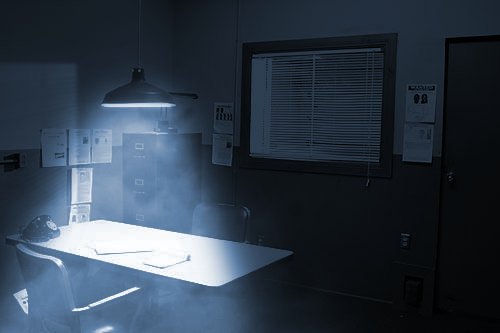
|
| The Night Chief was
elated, but puzzled too. Krajewski
was a pretty bad man, but hardly the type to be tagged as a
ruthless robber and killer.
From notations on the card Connolly determined that
Krajewski was then a little less than twenty-two years old.
Seven years before, he had been arrested for larceny
and juvenile delinquency and had received a year’s
probation. At sixteen
he had been nabbed in a dice game and fined five dollars.
A year later he was arrested on a petit larceny charge,
but the card didn’t show the disposition of the case.
At eighteen he had been arrested for burglary and
received an indefinite
term in Elmira Reformatory.
Then an interesting notation caught Connolly’s eye.
He called for the reports on the A&P stickups and
found that the first of the series had taken place on
November 25th, 1929
.
Checking back on
Krajewski’s record, the Night Chief learned that the suspect
had been released from the reformatory just a short while
before that date.
Quickly the word went out:
“Pick up Walter Krajewski. He’s
wanted for questioning about the murder of Patrolman Carl
Wunderlich.”
Armed with pictures of the
suspect, members of the homicide squad scoured the city, but
to no avail. After
prying around hi old hangouts, they got hold of an address.
They went there only to learn that Krajewski had moved
out a short time before without leaving a forwarding address.
The Headquarters men were
frankly stumped about where to look next.
It seemed to them that if their suspect were to be
found, he would have to be caught on the fly.
That was the status of the
case when I reported for my usual trick of duty with the
auto-squad on the chilly night of March 22nd.
It was a Saturday and Saturdays more than any other
nights meant trouble for our squad.
That was the night when merchants’ cash registers, as
well as the motion picture houses, were full, and the two
circumstances worked hand in hand for the benefit of the
gunmen.
The curbs of every block in
the downtown theater district were lined solid with parked
cars, and in the vicinity of every neighborhood movie house
were scores more.
It was a simple matter for
bandits to find a car that had been parked with the ignition
key in it, or to pick the lock or to wire around the ignition.
If they grabbed a car soon after it had been parked in
the theater district, they could be pretty sure of having two
and a half to three and a half
hours-until the show was over-to use the machine for
their own purposes before it was reported stolen.
Meanwhile, the robbery
reports would trickle in. If
a witness managed to catch a glimpse of the auto license,
invariably it belonged
to a stolen car, which would be found abandoned soon
afterward.
Lieutenant Britt and the
rest of our squad had been keeping a close watch on the
reports of recovered autos, to see what they could tell us.
The way we figured it, a holdup man or a pair of them
would abandon a car within a half-mile of their homes, so they
wouldn’t have far to walk. When
our checkup of the records showed that the overwhelming number
of stolen cars were recovered within a one-mile radius on the
East Side
, we figured that most of the gunmen lived in that area.
The Lieutenant’s
assignments were mad with that evidence in mind.
On that March night, six cars filled with auto squad
members were sent out roving on the
East Side
.
We wore plainclothes and our
cars carried no police signs. Only
the siren, if we were obliged to use it, revealed us as
policemen.
A few flakes of snow fell as
we drove about leisurely, our eyes fixed on the license plates
of cars that approached or passed ours, ready to check a
number against the list of stolen cars that dangled from our
dashboard. Whenever we
were in the vicinity of a precinct station, one of us stopped
“hot” cars to add to our list and checked with
Headquarters.
That night we had a big old
touring car with side curtains.
I was at the wheel and our squad leader, Detective
Louis M. Klein, rode at my right.
“Keep your guns handy, boys” he reminded us more
than once. “Remember
one of these guys may be the Wunderlich killer. |
|
|
|
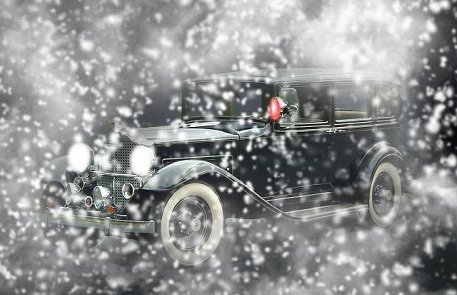 |
Ordinarily Detectives
Fred Rambuss and Guy C. Dewey would have been with us, but
because of absences of other squad members due to illness and
days off that pair was assigned to another car.
In their stead Detectives John W. Crotty and |
|
John
Hamrahan were occupying the rear seat of our big Packard.
Crotty, whom we had nicknamed
“Two-gun,” carried his usual arsenal of two service
revolvers. Hanrahan had
a shotgun ready for instant service.
Klein and I each had a Police Positive in shoulder
holsters.
In the course of our prowling, we stopped
at the twelfth precinct station on
Genesee Street
to check in.
Klein emerged from the station and
reached for the stolen car list.
He added a license number and explained, for our
benefit, that it was a Chevrolet touring car reported at
10:57 pm
as stolen from Broadway and
Ellicott Street
in the theater district. The
owner was William Kunz of
337 Germain Street
|
|
|
|
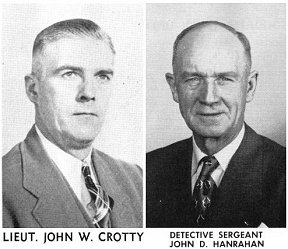 |
We resumed our
cruising. After
traversing several streets in the heart of
Buffalo
’s Polish-American
center, we swung out
Walden Avenue
for a few blocks. As we
neared the trolley barns, a touring car with a winter top
approached us, climbing the grade from a railroad underpass.
By the beam of our headlights I caught the last four
numbers of its license.
“Get the first numbers of that Chevy.”
I flung over my shoulder at the detectives in the back
seat. “It’s a hot
car.” I repeated the
numbers I had caught to Klein and almost simultaneously Crotty
gave him the first numbers. “Yes,
that’s the last one on our list,” Klein confirmed.
“We’d better give him a looking over.”
|
| Already I was swinging the big Packard into the track area
in front of the trolley barns for a quick turn around.
Apparently
the driver of the stolen car became apprehensive, for he
quickly put on speed and swung sharply left into
Lathrop Street
, which we had passed
only a moment before.
Headed about, I shoved my foot on the accelerator and we
thundered in pursuit. The
car swayed dizzily as we swerved into
Lathrop Street
and saw the Chevrolet already half a block away.
Once under way on a straight stretch, the Packard was
swift. Slowly we began
to close the gap. But
busy
Sycamore Street
was the first intersecting thoroughfare and we were forced to
unleash the siren to warn other traffic away as we hurtled at
more than fifty miles an hour across the intersection.
Our hopes for a quick and
quiet pickup were destroyed as thoroughly as our screaming
siren shattered the peace of the neighborhood.
Halfway down the next block
the Chevy appeared to slow up as it swerved toward the curb.
Evidently the driver thought to leap from the stolen
machine and dash away on foot, but we were gaining too
rapidly.
Changing his mind, the
fugitive pressed on the pedal and the light car leaped ahead.
He hardly cut his speed as he approached crowded Broadway,
yanked the wheel into a right turn and a short block farther
turned right again, doubling back on us.
Close behind as we neared
Broadway, we soon lost our advantage.
The big gain we made on the straightaway was lost on
turns and in traffic, where the smaller car could be
maneuvered more readily.
Picking up speed again, we
zigzagged in pursuit, turned west into
Sycamore Street
and sped on. We had
nearly closed the gap again as we approached
Mills Street
with siren shrieking.
The fugitive driver, already
aware that he had an advantage on every turn, whirled toward
the intersection at full tilt, made a quick right angle and
fled northward. Our
heavy car screamed in anguish as I tried to duplicate his
quick turn and an echoing yell came from the back seat.
“Heh, you trying to kill us? Shrilled one of our
detectives recovering his equilibrium after being hurtled
against his companion.
Klein had his revolver out,
ready for action, and mine hung loose in my holster, but we
dared not shoot, for we didn’t know whom we were chasing.
Our elusive quarry might be a high school boy who had
swiped a car for a joyride, in which case wee would be
severely criticized if we were to kill or wound him.
On the other hand, if he
were a desperate gunman we would be just as severely
criticized if he got away, and there was a very good chance
that he might, if some unwary motorist were to get mixed up in
the pursuit.
At the next cross street the
Chevy swung right then sped for eighteen blocks on a
meandering route that nearly duplicated the earlier stage of
the chase. It brought
us to
Genesee Street
, where we tore along between two lines of traffic.
The stolen car dipped into
the railroad underpass and swerved right again into the next
intersecting street with our curtained juggernaut less than
100 yards behind. |
|
|
|
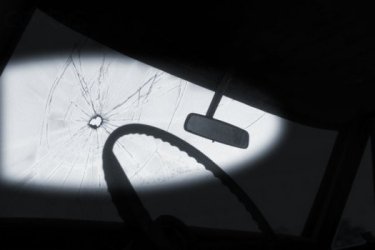 |
We were slowing down
slightly to make the turn when a shot shattered the center of
our windshield. A
vacant lot on the corner had given the fugitive a chance to
fire out of the right side of his car into ours without
slackening speed.
“Anybody hurt? I yelled at
Crotty and Hanrahan in the back.
“No, it missed us” they returned.
It was a miracle none of us was hit for as we
determined later the bullet had passed directly between Klein
and me and had continued through the back curtain.
|
|
“Okay, let him have it,”
Klein gritted. “He
asked for it.”
Another shot splattered
against our radiator. Klein
pushed his revolver through the opening of the side curtain
and fired.
We had no doubt now of the
kind of customer with whom we were dealing, but we still
weren’t certain that the driver was alone in the Chevrolet.
We only knew that at any cost, we must overhaul him,
forcing him to the curb if possible.
He must not get away.
A spray of glass showered us as another shot struck our
windshield. Klein
pulled out a big piece of loose glass and Hanrahan, standing
up in the rear, leveled his shotgun through the opening and
fired a blast. Crotty’s
and Klein’s Police Positives spoke sharply.
It was impossible to know what mark their shots had found
for the Packard was swaying down straightaways and careening
around corners, flinging my passengers from side to side and
upsetting their aim.
No longer were we losing so much distance on the turns.
I was driving out in the center of the streets, ready
for a turn either way and taking them with hardly a letup in
speed barely missing the far curb on each one.
The fugitive resumed his grim game of twisting, turning,
ducking in and out of traffic, in a desperate effort to shake
off our relentless pursuit.
Every few minutes we would catch a flash in the car ahead
and a “ping” would resound on our machine.
My companions would fire an answering salvo whenever it
was safe. He didn’t
care whom he killed, but we had to be cautious so we
wouldn’t hit an innocent bystander. |
|
|
|
 |
Through a maze of streets the chase led
again to
Sycamore Street
, a main East-West artery.
|
| A woman screamed and fled from the street
to the sanctuary
of the sidewalk as the two machines took the turn on two
wheels.
A revolver spoke and out of the tail of my eye I saw a man
duck into the protection of a doorway.
A quick turn and we wheeled north, around the block and
back toward sycamore.
Into that busy thoroughfare we plunged, to come as close to
sudden death as any of us has ever known.
Sycamore is one of the liveliest streets on the East side
and its intersection with
Fillmore Avenue
is near the center of the section’s business district, which
is jammed with shoppers and merrymakers on a Saturday night.
As we approached
Fillmore Avenue
, the signal light turned red but the Chevy plunged ahead,
getting the jump on the cross-traffic.
Even so a car quick on the pickup sprang from the waiting
line of cross-traffic and whirled across the intersection
barely missing the rear of the stolen machine.
Tearing along close behind at sixty to seventy miles an
hour, with siren screaming, we couldn’t have stopped if we
had wanted to. It
appeared certain that we would plow into the car that was
cutting across our bow.
I swung the wheel hard to the left; the Packard shivered in
every brace and beam. It
almost seemed to me that I could smell hot metal as the other
car slithered past. I
still am not sure whether we scraped it, but I never want to
come closer. |
|
|
|
| Past the intersection,
we quickly gathered speed again.
My companions in the back seat were silent, trying to
keep right side up in the thundering chariot as they took aim
between the ears of Klein and me in front and fired at the
elusive target ahead.
Avoiding the rough cobblestones of
Sycamore Street
, both autos swung into the trolley tracks.
We were by then only two car lengths behind.
My fellow detectives had ceased firing.
“They must have emptied their guns.”
I thought, “and they can’t reload with the car
swaying like this.” |
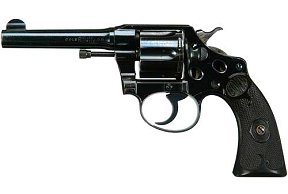 |
| Out of my
shoulder holster I snatched my own revolver.
Smashing out a piece of glass, a remaining fragment of
the Packard’s windshield, with the butt, I rested the gun
barrel on the metal frame and fired-one, two, three, four
shots.
The Chevy continued straight ahead.
I decided I must save one shot for our protection when we
overhauled our quarry. “I’ve
got to make this next one good,” I resolved.
I took careful aim and fired.
The Chevy continued on its course.
“Hang on, I’m going to belt him!” I yelled at my
companions, bringing the Packard’s speed down to the
Chevy’s so we would escape serious injury in the collision.
We had just passed
Walnut Street
when I pressed a bit more on the accelerator and our heavy
machine plowed into the light car ahead.
It jumped out of the car tracks and veered to the
right. For half a block
it edged toward the side of the street, hurdled the curb,
plunged straight into a fire hydrant and an adjoining power
pole. The pole snapped
near its base. The
Chevy came to a halt-after a five-and-three-quarter-mile
chase.
A sudden swerve to the left and a quick
cutback, as a car approached from the opposite direction and
the Packard was brought under control.
A geyser of water gushed from the smashed hydrant as I
pulled up ahead of the battered car that we had pursued for
sixty-nine city blocks.
We pile out.
With revolver leveled and only one shot remaining in
it, I approached the stolen machine.
Then I returned my pistol to its holster.
Before me, lying with his head hanging out of the open
door on the driver’s side and his body slumped behind the
wheel was the gunman. He
must have been dead before our car rammed his. |
|
|
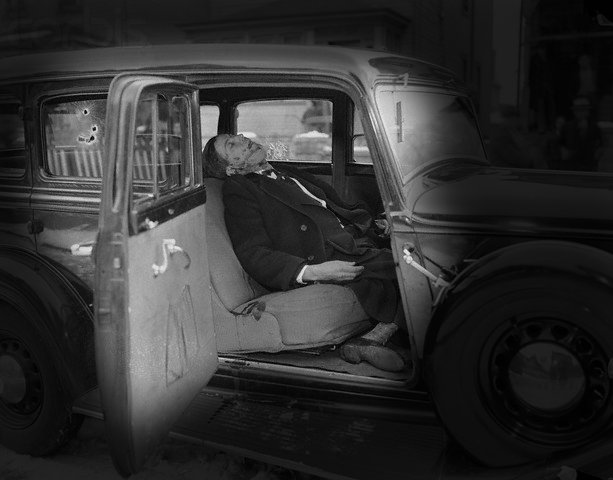
|
|
|
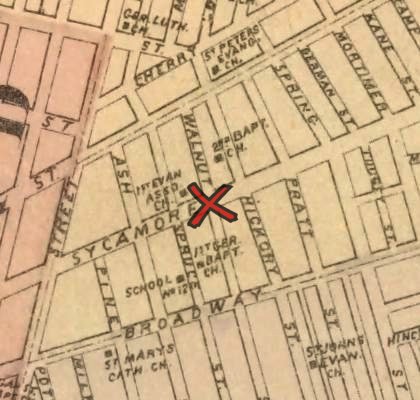 |
Klein, Crotty, and Hanrahan lifted him
out and carried him across the street, where they laid him on
the snow-covered ground.
I waded through the freezing water,
fishing for his weapon. After
a few minutes I found it-a nearly new Colt .38.
Opening the gunman’s coat, we found he was wearing a
new shoulder holster and he had a box of cartridges in a
pocket.
Meanwhile, Police Headquarters had been
deluged with reports of a gun battle on the
East Side
. It was only a few
minutes before
|
|
Commissioner Roche and Night Chief Connolly
arrived with a squad of Headquarters men.
Connolly glanced at the body on the
ground, then fished in his pocket brought out a picture and
made comparisons.
“This is Walter Krajewski-the fellow who killed Carl
Wunderlich,” the Night Chief declared.
“And we’re just lucky he didn’t kill us, too,”
I commented.
An hour later Connolly’s identification
was proved correct. Summoned
from their beds, Acting Manager Braun of the A&P store and
Kelly, the man who saw
Wunderlich’s slayer flee from the store, picked our
victim’s body from five others in the morgue.
At Braun’s request, an attendant
flipped back the dead man’s lip.
There was the greenish-hued tooth that Braun said was
so prominent when the A&P bandit, his lip writhing,
snarled his commands at the chain store manager nearly seven
weeks before.
Fingerprints proved that the dead man was
Krajewski.
The Medical Examiner found a bullet hole
in Krajewski’s head, evidently made by the last shot I had
fired.
A short while later, the four of us who
participated in the pursuit and killing of Patrolman
Wunderlich’s slayer received checks for $250 each, equal
shares of the reward posted by the Great Atlantic &
Pacific Tea Company.
Detective Henry Wunderlich, who was
detailed to another auto squad patrol that night, was well
satisfied with the outcome of the case.
“I didn’t want any part of the
reward,” he told me. “I
just wanted to get the rat who killed my brother.
I’m glad you nailed him.”
The back of the stolen car had been
peppered with twenty-nine shots.
Our own big vehicle was ready for the junk heap, its
bullet-riddled radiator dry and the motor ruined.
But it had served well in bringing to an end the sordid
career of a young man who had graduated from petty crime to
banditry and thought he could get away with murder. |
|
|

|
|
|
|
Note
Lieutenant George F. Tourjie former
Sergeant of Marines was presented with the William J. Conners
gold medal on
December 18th, 1980
for the most meritorious act performed by a
Buffalo
police officer during the year.
He was elected by the three
Buffalo
police inspectors, Thomas J. Gilligan, James Hyland and John
S. Marnon, comprising the award committee, to receive the
medal for his work on the case about which he tells in the
foregoing article.
As Fred M. McLennan, managing editor
of the Courier-Express, pinned the medal on Tourjie’s
breast, he said:
“The smashing blows struck against
murderous thieves last March brought to an abrupt end a
gangster outbreak that boded ill for the peace and good name
of the city. We are all
inclined to be hero worshippers.
We are apt, however, to turn back the pages of history
and pay homage to
heroes whose deeds are no more meritorious than those that
occur before our eyes. In
the warfare against gangsters the members of the
Buffalo
police force have demonstrated that they are of the right
caliber to form that thin blue line that stands between the
law-abiding citizen and the felon.
George F. Tourjie, recipient of the medal this year is
an outstanding example of the brave, efficient police officer.
Detectives John Hanrahan and John W.
Crotty were awarded departmental medals for meritorious
service in connection with the same case. |
|
|
|
|
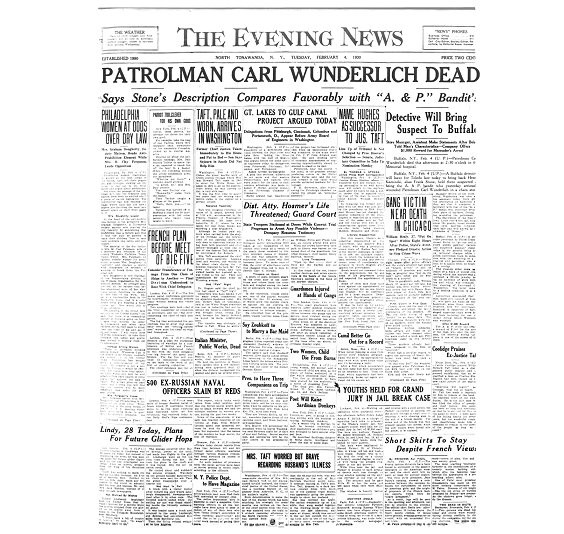
|
|
|
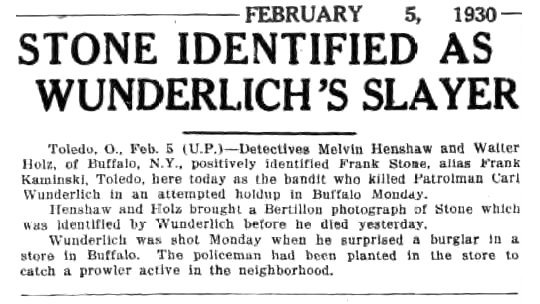
|
|
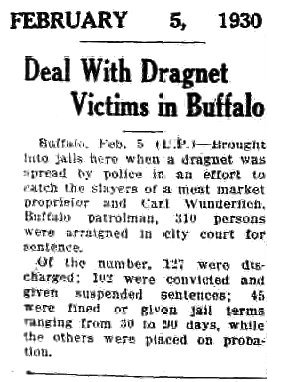
|
|
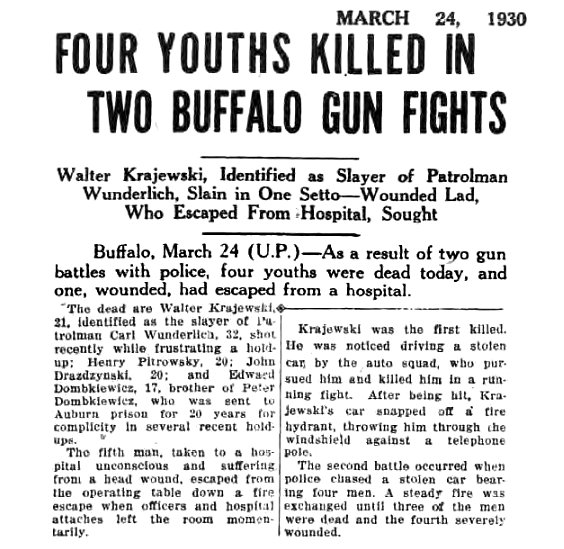
|
|
|
|
Note Crime Scene Photo Not Authentic
|
|
 |
OFFICERS
MEMORIAL
POLICE VEHICLES
POLICE BADGES
AMUSEMENT
ACKNOWLEDGEMENTS
LINKS
IN
THE NEWS
1800's
1910's
1920's
1930's
1940's
1950's
|
1960's
1970's
1980's
1990's
2000's
2010's
|
POLICE OFFICERS
Chief Executives
On the Job
Police Officers
History of Police Woman
History of Black Officers
Meet Detective Sergeant Coyle
Meet Detective Sergeant Burns
Meet Patrolman Nicholas Donahue
Buffalo Housing 1980's
Precinct 16
Days Gone By
POLICE SQUADS
Underwater Recovery Team
Homicide Cold Case Squad
CSI Crime Scene Investigation
S.W.A.T.
Mobile Response Unit
K-9 Corps
Communications Division
Motorcycle Squad
Mounted Division
Band and Drill Team
Cartography Unit
Pawnshop Squad
Printing Department
Identification Bureau
HISTORY
History Overview
Police Precincts
Mutual Aid
World War II
Desert Storm
CRIME STORIES
Detectives 1980
The Blue Ribbon Gang
The Mystery Perfume Case
The Felons Fang
Contract For A Hit
An Eye For Murder
The Boarder Bandits
Detective William Burns
MOB
STORIES
Callea Brothers Murders
Magaddino Cheats Death
Aquino Brothers Murders
DeLuca Gangland Murder
Battaglia Gunned Down
Gerass Found In Trunk
Cannarozzo Shooting
Albert Agueci Murder
Birth Of Witness Protection
Murder Gangland Style
How America Meets The Mob
Anti-Gambling Crusader Murder
The Easy Money
|

























